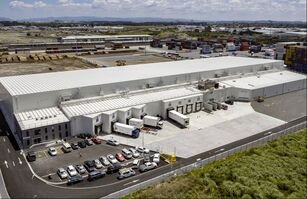TVNZ's Auckland facility has significantly trimmed its electricity costs following the installation of an automated load-management system that shifts mains power supply to in-house generators during high-tariff periods.
|
TVNZ's system was designed and installed in 2017 and includes our Quasar Control software which monitors the tariffs on the spot-price electricity market. These fluctuate constantly, and when the tariff approaches or exceeds a predetermined point, the software switches designated components of the building’s load from mains power to the in-house generators. When the tariff falls, the supply automatically shifts back to mains.
“Two objectives underpinned our decision to install the system,” says Lyall Sullivan, TVNZ’s technical services manager. “An easy, 24/7 real-time mechanism for price-point control and saving power costs was the prime motivation. But we also wanted to be bring control of the building’s entire electrical infrastructure into a single, central point, to simplify operation. Quasar’s system does both perfectly.” |
|
Installation
Installation involved a Quasar crew as well as TVNZ personnel. “ln addition to loading the software on to a server,” says Lyall, “the Quasar team configured and programmed a single PLC and installed it in one of our switchboards. My team was responsible for running new power and data cables, to interconnect different sections of the building, bringing everything to a central control room. “It all happened very quickly and seamlessly, and the technology was running perfectly a month after the project began.”
TVNZ’s opted to install the technology following a change to the way electricity prices were charged. “Previously,” Lyall explains, “we were being charged a fixed tariff, with no scope to alter it by operating more efficiently. By changing to a fluctuating, spot-price mechanism, the ability to achieve significant savings was immediately obvious. We therefore called Quasar.”
TVNZ’s opted to install the technology following a change to the way electricity prices were charged. “Previously,” Lyall explains, “we were being charged a fixed tariff, with no scope to alter it by operating more efficiently. By changing to a fluctuating, spot-price mechanism, the ability to achieve significant savings was immediately obvious. We therefore called Quasar.”
“We can take advantage of the spot-price market with the ability to switch to the generators when the tariff gets too high. It can change very quickly, and the automated system also means we won’t be caught by surprise.”
Lyall Sullivan – TVNZ technical services manager
How Quasar Control works
|
The TVNZ building’s average electricity load is around 1.2MW, spread across 12 distinct ‘load groups’. The biggest consumers by far are the chillers, pumps and the air-conditioning system.
“We have two 1600 kVa Caterpillar generators in the basement,” says Lyall, “and if the tariff climbs to our system’s pre-determined price point, the software automatically cuts the mains supply and starts up one or both of the generators. The entire changeover over takes 15 – 20 seconds. Obviously, there are sophisticated UPS systems in place, so there are never any outages.” |
Benefits of the Software
A major benefit of the software, he adds, is the easy-to-understand graphic interface it provides. “I can sit at my desk and explore the various factors determining our electricity costs – all in real time. The ‘dashboard’ displays information about the electricity market, the loads at different parts of the building, the status of various bits of equipment – it’s all there.
"It also has a valuable built-in feature that generates trends and patterns for easy analysis, as well as an ‘alert’ facility that messages me and the rest of my team if any anomalies are detected.”
Before the building’s electricity control was reconfigured to a central station, operators would have to move between the various load centres to physically throw switches at the different switchboards. Now, the software does it all remotely – all 12 load groups can be switched instantaneously from a central point.
Lyall says the Quasar software also allows TVNZ to take advantage of special tariff offers from Transpower. “We’ve signed up to Transpower’s ‘demand-response’ programme. Essentially, the supplier needs to shed load from the overall system when demand is high. “If large customers like TVNZ are able to reduce overall load easily by switching to in-house power for short periods of time, Transpower is better able to manage its load profile. It’s a kind of win-win situation for both organisations.”
Lyall says the Quasar software also allows TVNZ to take advantage of special tariff offers from Transpower. “We’ve signed up to Transpower’s ‘demand-response’ programme. Essentially, the supplier needs to shed load from the overall system when demand is high. “If large customers like TVNZ are able to reduce overall load easily by switching to in-house power for short periods of time, Transpower is better able to manage its load profile. It’s a kind of win-win situation for both organisations.”
Quasar Control
Learn more about Quasar Control
|
Lineage LogisticsRead about how Quasar Control helps Lineage Logistics
|
University of Canterbury
Read about University of Canterbury's power monitoring system
|




